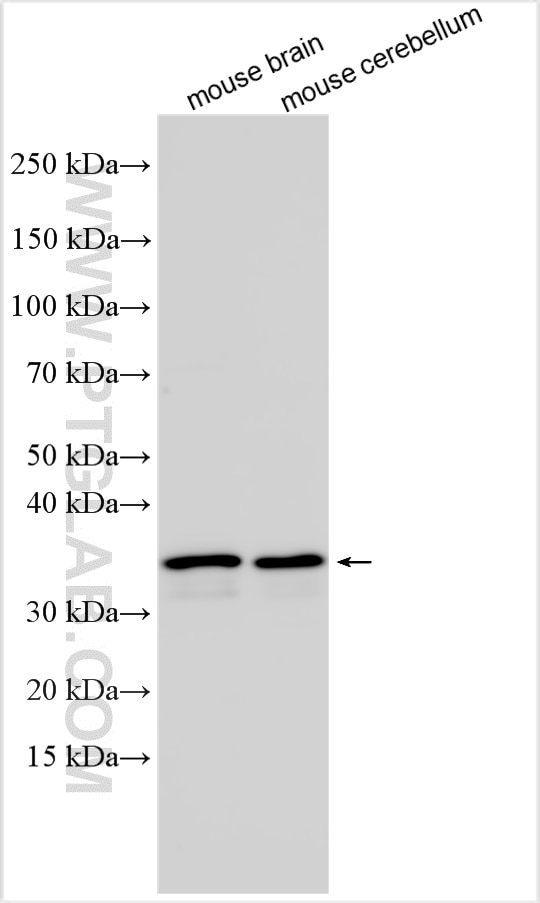Tested Applications
| Positive WB detected in | mouse brain tissue, mouse cerebellum tissue |
Recommended dilution
| Application | Dilution |
|---|---|
| Western Blot (WB) | WB : 1:1000-1:6000 |
| It is recommended that this reagent should be titrated in each testing system to obtain optimal results. | |
| Sample-dependent, Check data in validation data gallery. | |
Product Information
26763-1-AP targets OLIG1 in WB, ELISA applications and shows reactivity with human, mouse samples.
| Tested Reactivity | human, mouse |
| Host / Isotype | Rabbit / IgG |
| Class | Polyclonal |
| Type | Antibody |
| Immunogen |
CatNo: Ag25128 Product name: Recombinant human OLIG1 protein Source: e coli.-derived, PGEX-4T Tag: GST Domain: 1-87 aa of BC026989 Sequence: MLRPQRPGDLQLGASLYELVGYRQPPSSSSSSTSSTSSTSSSSTTAPLLPKAAREKPEAPAEPPGPGPGSGAHPGGSARPDAKEEQQ Predict reactive species |
| Full Name | oligodendrocyte transcription factor 1 |
| Calculated Molecular Weight | 28 kDa |
| Observed Molecular Weight | 34 kDa |
| GenBank Accession Number | BC026989 |
| Gene Symbol | OLIG1 |
| Gene ID (NCBI) | 116448 |
| Conjugate | Unconjugated |
| Form | Liquid |
| Purification Method | Antigen affinity purification |
| UNIPROT ID | Q8TAK6 |
| Storage Buffer | PBS with 0.02% sodium azide and 50% glycerol, pH 7.3. |
| Storage Conditions | Store at -20°C. Stable for one year after shipment. Aliquoting is unnecessary for -20oC storage. 20ul sizes contain 0.1% BSA. |
Background Information
The oligodendrocyte lineage-specific basic helix-loop-helix (OLIG) family of transcription factors includes OLIG1-OLIG3, which differ in tissue expression. OLIG1 and OLIG2 are specifically expressed in nervous tissue as gene regulators of oligodendrogenesis. OLIG1 and OLIG2 interact with the Nkx-2.2 homeodomain protein, which is responsible for directing ventral neuronal patterning in response to graded Sonic hedgehog signaling in the embryonic neural tube. These interactions between OLIG proteins and Nkx-2.2 appear to promote the formation of alternate cell types by inhibiting V3 interneuron development. OLIG1 and OLIG2 are abundantly expressed in oligodendroglioma and nearly absent in astrocytomas. Therefore, OLIG proteins are candidates for molecular markers of human glial brain tumors, which are the most common primary malignancies of the human brain.
Protocols
| Product Specific Protocols | |
|---|---|
| IHC protocol for OLIG1 antibody 26763-1-AP | Download protocol |
| WB protocol for OLIG1 antibody 26763-1-AP | Download protocol |
| Standard Protocols | |
|---|---|
| Click here to view our Standard Protocols |








